No products
Prices are Management included
You love your minimalist shoes and your feet are super happy in them, but you may have had these questions on your mind:
How do you clean your minimalist shoes?
Do they have any maintenance?
Can I put them in the washing machine?
If a seam pops out or the sole comes off, can it be repaired?
Don't worry.
There is no drama.
All of them (and more) have answers and solutions.
And so that they are always at hand, you have them all here (whatever the brand it is) so that you can continue to enjoy them to the full.
In the case of children’s footwear, our little ones run, jump, kick balls, slide… they’re not made of porcelain; they’re full of life and need to play. It’s an essential part of their development.
That’s why it’s natural for their shoes to show signs of wear, even from the first times they’re worn. This is not considered a defect but rather a result of their activity and enjoyment.
A) Cleaning
- Textile footwear
- Leather footwear
- Leather or suede footwear
- Drying and Dryer
- Odours
- The edge of the shoe around the ankle is a different shade, why?
- Huaraches and sandals: Can they get wet?
B) Restoration-Repair
- Seams and unpicking
- Peeling and soles
- Rivets and pins
- Laces
- Hole in the inner fabric, why does it happen and what is the solution?
- Hole in other part of the fabric, why does it happend and what is the solution
- Straightening shoes
- Removable insoles move, what do I do?
C) Care and maintenance
- Leather footwear
- Leather or suede footwear
- Waterproofing footwear
- My feet get wet even wearing waterproof footwear
- Difference between waterproof and waterresistant/hydrofobic
- Safety footwear rubs me in places. What is the reason and how do I solve it?
- My Feroz have the sole of a different shade in certain parts, is this normal?
A) Cleaning
Textile footwear
The best way to clean textile shoes is first with a soft brush and then with a damp cloth.
If the dirt is heavier, you can apply a little soap to the damp cloth.
Washing machine Yes or No?
Yes, but it depends.
The less the better, as hot water and detergents can damage or shrink fabrics, weaken seams and fade colour.
That's why, if you need to use the washing machine, always use a cold wash programme. Then air dry in the shade.
Leather footwear
The best way to clean leather shoes is to first use a soft brush to remove any dust and then wipe them with a damp cloth.
You can apply alcohol to the cloth to clean even better.
Washing machine Yes or No?
No, leather shoes (whatever type of leather they are) cannot be put in the washing machine.
Leather or suede shoes
In the case of suede, the best way is to brush them with a special shoe brush with stiff bristles (always brush in the same direction, from the instep to the toe and from top to bottom).
If they are clean after brushing... perfect!
If there are still some stains, rub gently (always dry) with a small scouring pad in circles.
If there are still stains, slightly dampen the surface of the shoe (do not put it under water). Now rub gently with the small sponge (this time dampened and, if necessary, with a little neutral soap) until the stain disappears.
After each case, if you want, apply a nourishing product according to the type of leather finish.
Washing machine Yes or No?
No, leather shoes (regardless of the type of leather) cannot be put in the washing machine.
Drying and Tumble Drying
To dry your shoes, it is best to leave them in the air and in the shade (do not expose them to direct sunlight).
Do not put them in the dryer, as the high temperatures can deform the footwear and even cause the fabrics to shrink.
Odours
The issue of odours is a very personal one (some smell subtle and others strong, like cheese). And they are linked to perspiration: some feet perspire more and others less.
That's why if you wear a shoe with water-resistant or waterproof mesh (which works to keep water and moisture out), the perspiration (sweat) from your feet can't escape fast enough and can stay inside the shoe/boot. Impregnating the inner fabrics with this sweat.
Don't worry, one way to reduce the odour is to remove the insoles (if the shoe has removable insoles), wash them and leave the rest of the shoe exposed to the air for many hours (for example, leave them outside overnight).
Another trick is to put some perfumed wipes inside them (like baby wipes) so that their scent impregnates the inner fabric. You can even impregnate the wipe with a cologne or fragrance you have at home.
The edge of the shoe around the ankle is a different shade, why?
In shoes, especially in leather or microfibre, the area around the ankle can normally have a slightly darker shade or appear to have lost tone. It's slight, but if you look very closely you can see it.
This is something that makes you think: "If I've just taken them out of the box...have they been worn?"
The answer is: "No, they haven't". And the explanation is very simple.
All the shoes have been treated and dyed to give them that special look, shiny or spotlessly white.
But being in the box, leaning towards one of its sides, in those small points that have been in contact with the paper/box, it has been possible to transfer a little bit. This means that the tone does not show up with the brightness or tonality of the rest of the shoe.
Now that you know this, you can rest assured that your shoes are brand new!
Can I get my huaraches and sandals wet?
Yes, but be careful!
As long as it is fresh water: like in the shower, when crossing rivers,...
But if they get wet with sea water because you have taken a walk along the shore or in swimming pools with a lot of chlorine, you have to clean them and rinse them afterwards with fresh water: in the shower or with a hose.
Do not let them dry in the sun when they are wet with salt water or chlorine. After rinsing with fresh water, leave them in the shade.
This will extend the life of your huaraches and sandals.
Black (or other color) leather shoes fade a little, reason and solution?
Colored leather shoes have a dyeing process to give them that beautiful look.
But this tint, especially in shoes that do not use any type of fixative, can come off a little the first time you wear it. Especially in these circumstances:
1. With the heat
2. And in contact with the skin. Especially in summer when you sweat the most.
Solution.
Although after the first few uses the excess will go away naturally, to speed up the process, you can wipe a damp cloth (for example a baby wipe) on the external or internal areas in contact with the skin.
This will help you remove any excess dye sooner.
B) Restoration-Repair
Sometimes shoes suffer from minor wear and tear that cause premature ageing of their lifespan. Sometimes these are aesthetic issues, which do not detract from the functionality of the footwear, but make it look old or damaged: cracks, tears, unpunctured soles, etc.
That's why below you will find the solution to each issue:
Seams and rips
Minimalist shoes can be repaired/restored just like any other shoes.
In fact, it's even easier, as they don't have any rigid elements, so it's very easy to work with them.
In case of a tear. Sometimes a hit or an overtension can cause a seam pop out or edge sticking separate a bit. But nothing that a few skilled hands at home or with the help of a local shoemaker can't solve easily and in no time at all.
Peeling and soles
Over time, due to not having any reinforcement in their construction, minimalists create greater bending and twisting angles, especially if your feet are extremely flexible.
But it's better that this tension disappears with a little bit of separation than by limiting the travel of your feet and causing you greater harm.
This small separation is totally aesthetic and is only visible in the brief moments of flexion. When the shoe is at rest (when you are standing still) it is not visible.
Even so, if you want, you can put it back together again in a very simple way. I explain you how in this video:
Shoelaces
The laces of your shoes suffer friction between them or with the environment, and sometimes, especially in children when playing, a blow or rubbing may have broken their fibres.
Don't worry.
You can replace it with another shoelace you have around the house. It doesn't have to be of the same brand as the shoe. You can buy it in any haberdashery or shop in your area.
If not, you can buy them here:
- For shoes/booties
- For boots
- For sport shoes
If the lace you are looking for is elastic for your children's shoes, you can substitute it for the elastic lace of a folder. It is totally compatible.
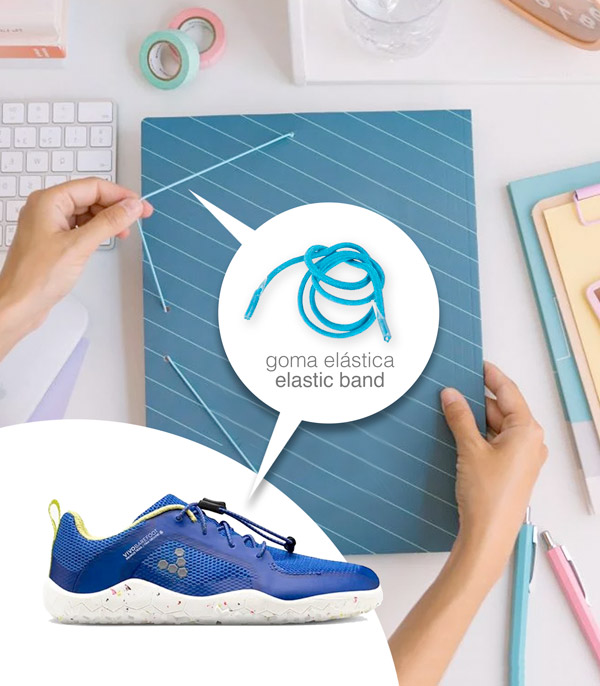
Hole in the inner fabric, why does it happen and what is the solution?
Minimalist shoes, despite appearing to have very little fabric, are made up of a combination of several layers that are barely visible.
OK, but... ah! am I seeing a little hole inside the mesh?
If so, that's the first inner layer of your shoes.
Surely if you move your toes upwards you can see that it coincides with the area where your toes, or rather, your nails, are. And yes, even if you wear socks it can happen.
Don't worry, your footwear has more layers, so it won't affect the performance of it.
But if you want to stop worrying about them and restore them in a jiffy:
The first thing: keep your nails nice and short.
The second thing: I put a small cloth patch underneath the area.
This way you get 2 things:
1 - You cover the hole (it won't be visible from the outside).
2 - You protect the fabric against any new internal friction between your fingers and the mesh.
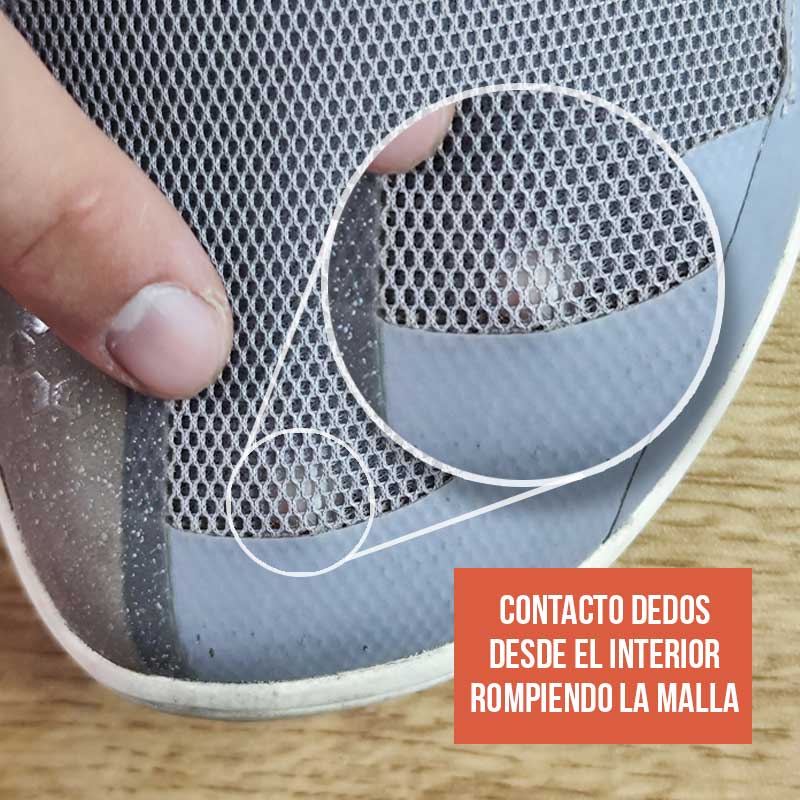
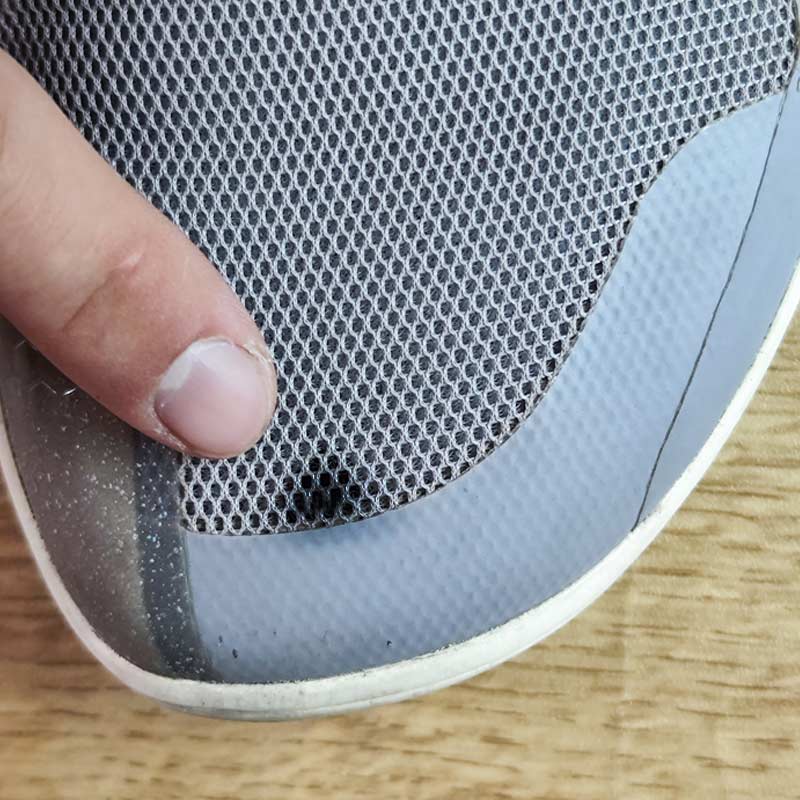
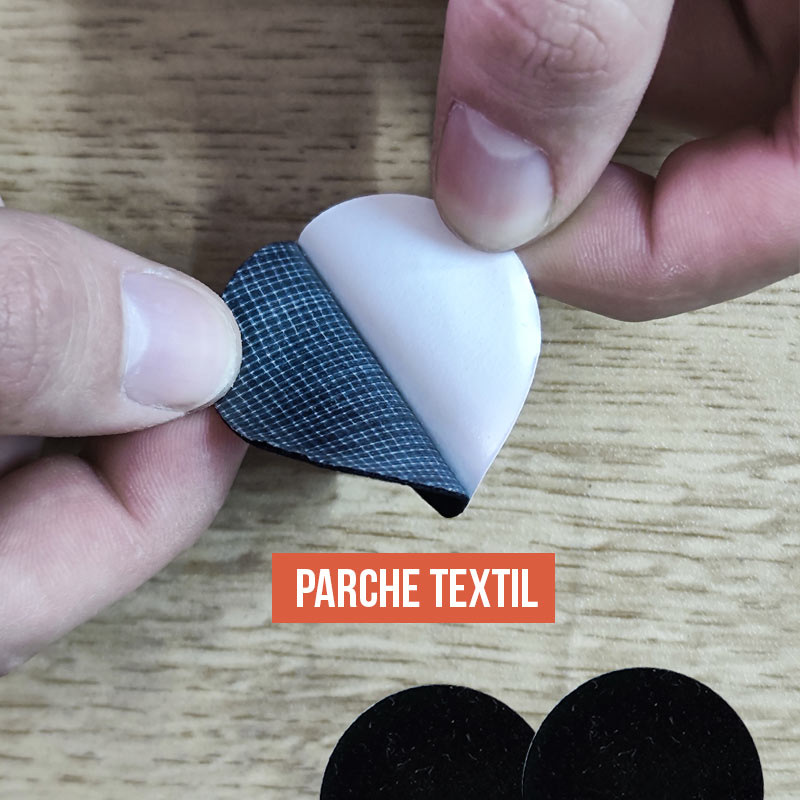
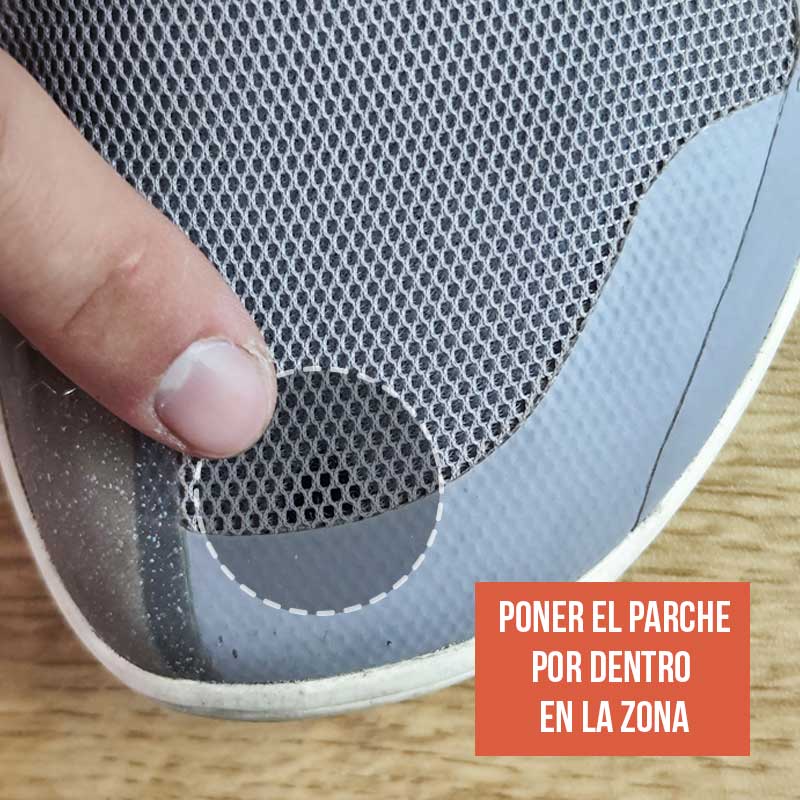
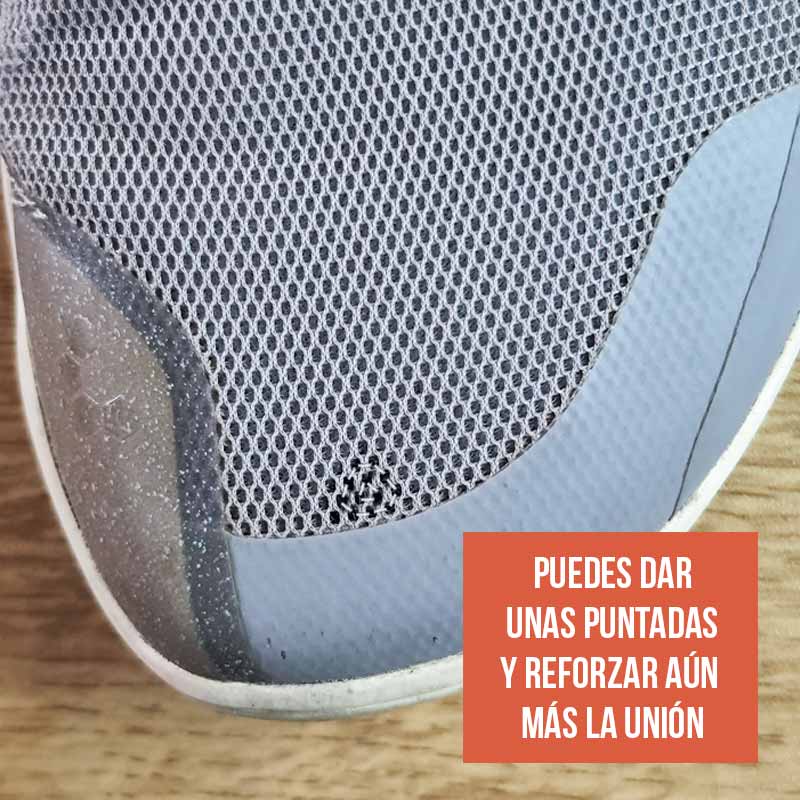
Hole in other part of the fabric, why does it happen and what is the solution?
Following the previous point, other parts of the fabric of your minimalist may suffer small tears and open up over time.
Most of the time it is the result of knocks or friction with external elements.
Something normal, since when we walk, we don't look at the ground.
But it can also be due to lack of maintenance or a great deal of use.
That is why it is very important to check them as soon as possible.
But if this has already happened to you, let me explain. It has a very easy solution.
As with a patch on your favourite garment, just take a needle and thread and cover the area using the pattern of the mesh. Look at the pictures.
You can even choose a colour that stands out, why hide it?
Make them unique and show them off!
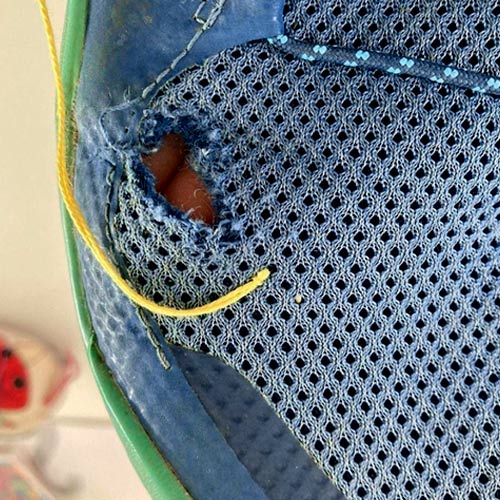
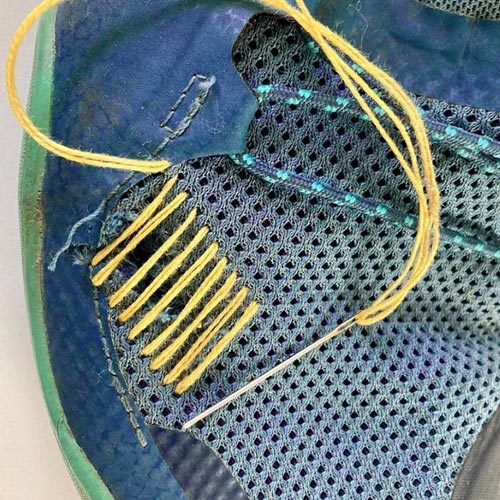
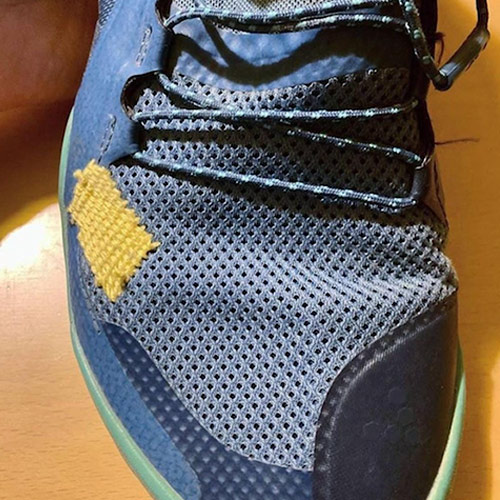
Play with shapes...
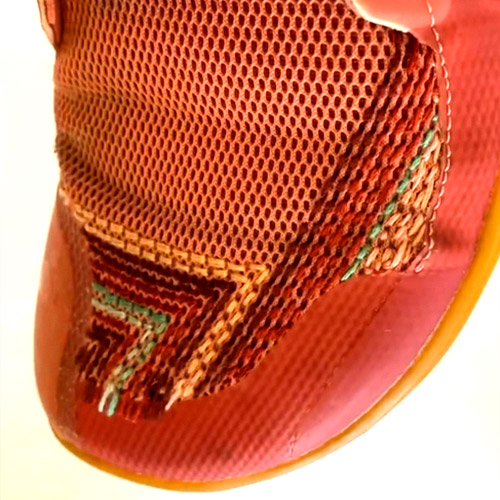
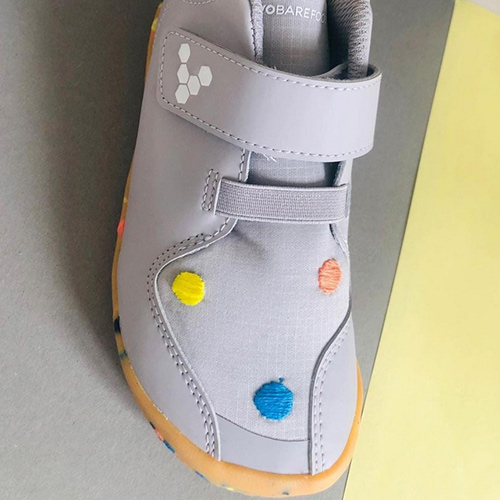
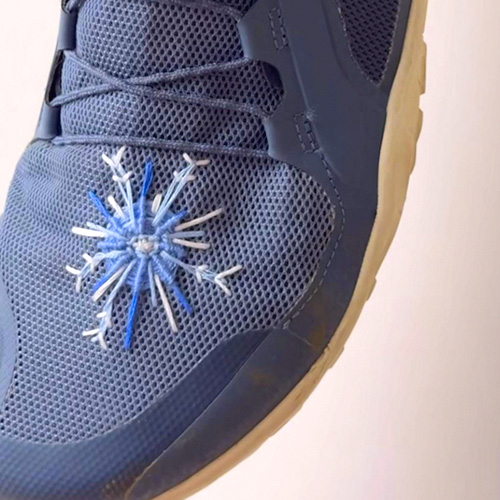
... and create wonderful things!
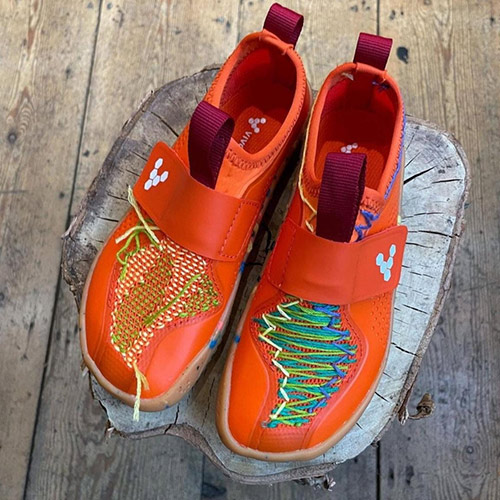
If you don't want to do it yourself, you only have to take them to a nearby shoemaker.
This professional shoemaker will do it for you in no time, in a very economical way and with a top quality result.
Keep on enjoying your shoes as you have been doing so far!
Straightening shoes
You've opened the box, you've put the shoes on the table and you see that one of them is turned a little bit inwards. What happened? Are they wrong?
Minimalist shoes do not have any kind of reinforcement, so they are very flexible and malleable. That's why they "do" the way they are put on. Like on your feet.
But in this case they have been made to the box, they have been in their box stored since their manufacture lying towards one of their sides, so they have been slightly turned in that direction.
Don't worry, you just have to do the same as with a washcloth. Turn it the other way round to "mould" it and put it back in its original position.
The removable insoles move, what do I do?
There are feet and strides that make the removable insoles move from their position when walking.
But don't worry, if this is your case or that of your children, it can be solved in a very simple way. All you have to do is put a piece of double-sided tape under the insoles.
That way it will be fixed to the shoe, preventing it from moving. And if you want to change or replace them later, you can easily remove them at any time by hand and put another one in.
C) Care and maintenance
Leather shoes
The care of your leather minimalist shoes is the same as any other natural leather shoes.
Just clean them first with a soft brush and then with a damp cloth. Then apply a colourless leather shoe cream (or the type of treatment you prefer) with a soft cloth or with the applicator in the treatment container of your choice.
Suede or suede leather footwear
In this case, you must apply a treatment according to the type of leather.
To do this, first brush them with a special brush for shoes with stiff bristles (always brush in the same direction, from the instep to the toe and from top to bottom).
Waterproofing your shoes
To waterproof your footwear, simply follow the instructions on the waterproofing product you have chosen for your textile or leather footwear.
Remember: you must choose a waterproofing product whose description indicates that it is valid for the fabric or leather of your footwear.
My feet get wet even wearing waterproof footwear
Sometimes you think you have all the security at home when you're are outside:
- armoured door with electronic security,
- motion sensors that are activated even when a fly passes,
- state-of-the-art alarm system connected to the police...
But one thing happened: you left the kitchen window open.
What a disappointment...
Such a simple thing with an open window has dismantled all that protection.
So then... whose fault is it?
Nobody's, nothing happened this time. But you know what you have to do to be absolutely sure. Now you know what to check before you go out.
This is very common and is what usually happens with waterproof footwear.
Being waterproof gives you the instant feeling that water will never get in. It's like an impenetrable castle.
I remind you again about the window. If it's not closed, water can get in. Even in a castle.
That's why we sometimes make the mistake of thinking that if it got in the first time, it means that the shoes or boots are not waterproof.
But what if it was because of the window?
How do I know if it is closed?
It's easy, you just have to take into account the following before going out:
- Check that my shoes are on properly
- The tongue is correctly positioned
- The lacing is correctly placed. If you wear it half-tied, the tongue and the rest will be more exposed to water.
But above all, and this is the biggest window of all, check the rest of the clothes you are wearing and how you are wearing them.
Not wearing it correctly causes capillarity to occur.
When you are exposed to water, it doesn't just get on your shoes, it also gets on your clothes.
Thanks to gravity, it accumulates in the lower part of your trousers. And this in turn, by contact, can wet the sock and/or the inner lining of the boot, which is visible at the top of the shaft. This causes the humidity to gradually move downwards until it reaches the feet.
This is the capillarity I was talking about.
That is why before checking if there is a problem, try to do a new test with the footwear completely dry, taking the above into account:
- Properly fitted tongue
- The correct lacing so that everything is well closed and there are no possible folds/openings where water can enter.
- Avoid capillarity by covering the boot well with the trousers (not tucking the trousers inside), so that the edge of the shaft is not exposed to water. If the trousers are waterproof, it is better, so that water does not accumulate in them.
Difference between waterproof and waterresistant/hydrofobic
Both terms seem to indicate that the shoe can resist water, but they do not do so in the same way.
The term "water repellent" refers to the ability of a material to repel water to some extent, preventing it from penetrating or being absorbed. This material protects against moisture and small amounts of water, such as splashes. In the case of water-repellent material, the pores are not sealed, thus favouring the breathability of the foot.
A waterproof shoe, on the other hand, resists the ingress of water and other fluids much more.
Shoes that have a water-repellent material or treatment are not waterproof, and this water-repellent coating must be renewed over time. There are sprays and treatments on the market that are very easy to apply to footwear.
So you only have to apply it according to the product's instructions and continue enjoying your footwear again as if nothing had happened!
Safety footwear rubs me in places. What is the reason and how do I solve it
Safety footwear is distinguished by being more robust than street footwear, since it must meet strict standards and requirements (such as the quality of materials, resistance and adequate protection). These characteristics are essential for this footwear to have obtained the certification of the required safety levels.
The morphology and volume of the user's foot also influences; Since it is a mass-produced product, the footwear is the same for everyone. So the sensation varies from one person to another.
The perception of comfort can vary significantly from one person to another.
Taking the above into account, in case of any possible initial discomfort, especially chafing which is more common in new shoes, it is recommended to use thicker socks. With use, the footwear will soften, including material, joints and other elements, becoming more flexible.
Meanwhile, if necessary, consider the use of internal protection that relieves direct contact with the skin and provides greater comfort during the adaptation period.
My Feroz have the sole of a different shade in certain parts, is this normal?
Feroz shoes have an incredible feature: their ultra-flexible soles. This makes you feel as though you're walking barefoot wherever you go.
This unique quality is achieved with just two things: a sole that is both thin and low-density.
What does that mean? Let me give you an example.
Imagine you're adding Nesquik or ColaCao to milk:
- If you add a lot, you get a dense, dark drink.
- But if you add just a little, it turns out light and translucent.
The soles of Feroz shoes work in a similar way.
Because they are so thin and low-density, they have a slight transparency that lets you see through them, like the glass of a shower screen.
This is why, in certain areas of the shoes, you can notice the color of the fabric underneath the sole. Over time and with use, this feature evolves, becoming visible in more areas depending on your movement.
This makes your shoes transform and adapt with you, like a chameleon, turning every pair of Feroz into something truly unique. No two pairs are ever the same!




























